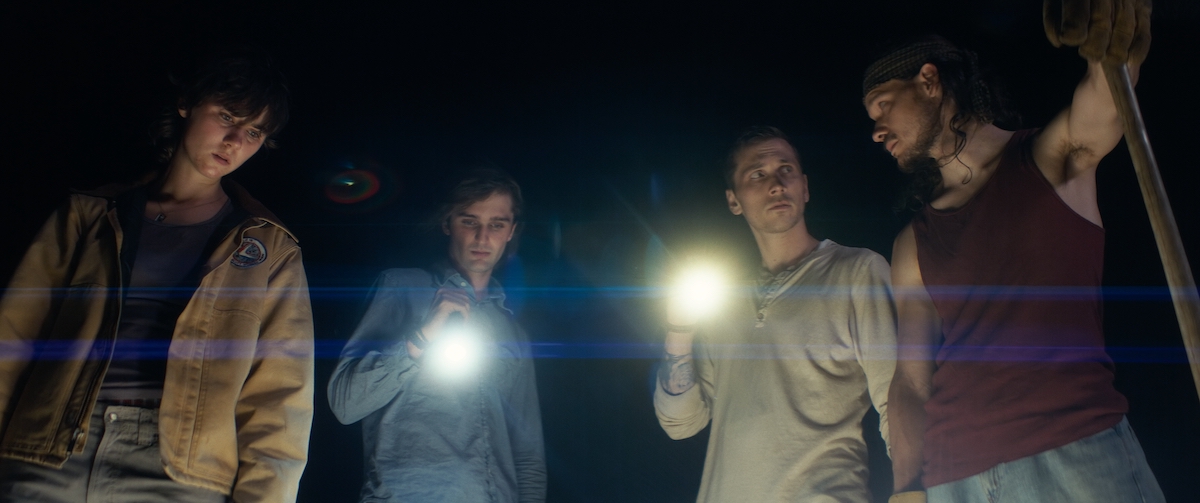‘Falling Stars’ Review: Folk Horror in the California Desert? Yes, Please
4/5 Joshua trees

The Mojave Desert, the vast stretch of land straddling Southern California and the southern tip of Nevada, is mainly known for its art colonies, sweeping vistas, and Joshua tree-studded badlands. However, the Mojave is filled with more weirdness and mysticism than most people know—and the new indie horror movie Falling Stars, directed by Richard Karpala and Gabriel Bienczycki, captures it perfectly.
Falling Stars, which had its North American premiere at this year’s Fantastic Fest in Austin, TX, tells the story of three brothers, Mike, Adam, and Sal (Shaun Duke. Jr., Rene Leech, and Andrew Gabriel). It’s October, the night of the first harvest and the start of a new year by certain calendars, and the brothers’ community has a tradition of putting out offerings for the witches who swoop down from the sky. When the brothers learn that a friend of theirs (Greg Poppa) has the body of a witch buried out in the desert, they succumb to curiosity and drive out to see it. They soon learn, though, that their curiosity may become their undoing. After all, harvest offerings are nice, but what the witches really want are human victims.
On the surface, folk horror set in the bright and sunny world of Southern California might seem odd—but only if you’ve never actually been here. Beyond the sliver of the coastline, California is home to thousands of square miles of rural communities filled with farmers, drifters, eccentrics, and religious zealots. With the Mojave’s seemingly endless stretches of sand and creosote, and an impossibly huge bowl of stars hanging overhead, the desert is the kind of place where legends are born.
Plus, this particular desert is home to more oddities than any one person can catalog. As Ken Layne chronicles in his radio show-turned essay collection Desert Oracle, numerous strange events have taken place in the Mojave. There’s the 1946 Babalon Working, an occult ritual performed by rocket scientist Jack Parsons and Scientology founder L. Ron Hubbard in the hopes of conjuring the Scarlet Woman (who purportedly took the form of artist Majorie Cameron). There’s Dwight Eisenhower’s rumored meeting with space aliens somewhere outside of Palm Springs. Then there are the amalgamations of Native and settler legends like the cryptid known as Yucca Man. This desert is bursting with life and lore.
In short, it’s a perfect landscape for the uncanny sensibility of a story like Falling Stars.
As a film, Falling Stars isn’t perfect. The plot feels stretched out, as if the filmmakers fought to get it to feature length. Still, even though some scenes drag and all the film’s parts don’t quite add up to a satisfying whole, the pervasive sense of dread is more than enough to keep you invested. There’s no obvious VFX in this movie, which relies on camera cuts and other practical effects for its scares. Along with the brothers, the film contains a cast of idiosyncratic characters, like the skeptical A.M. radio host Barry (J. Aaron Boykin) and a loner who adorns himself with animal skulls (Piotr Adamczyk). The movie is rich in atmosphere, including creepy scenes in which the brothers journey through the the nighttime desert with only an automated wind advisory on the radio to keep them company. The result is a vivid and eerie world with unspeakable danger hovering just out of sight.
It’s easy to write off the desert as an uncomfortable place to go camping, or a tourist attraction to cross off a list. But as Falling Stars shows, the desert is so much more than that. It’s a place where you can find your soul just as easily as you can lose your life, and where the innumerable stars are both wondrous and terrifying.
(featured image: Raven Banner)
Have a tip we should know? tips@themarysue.com